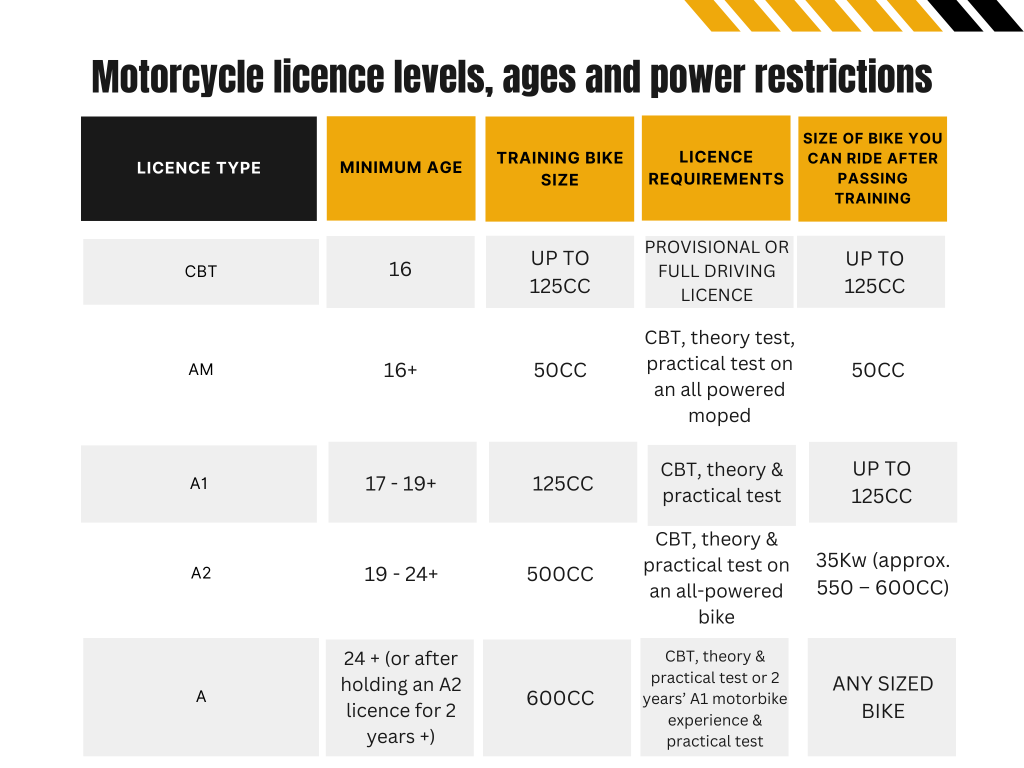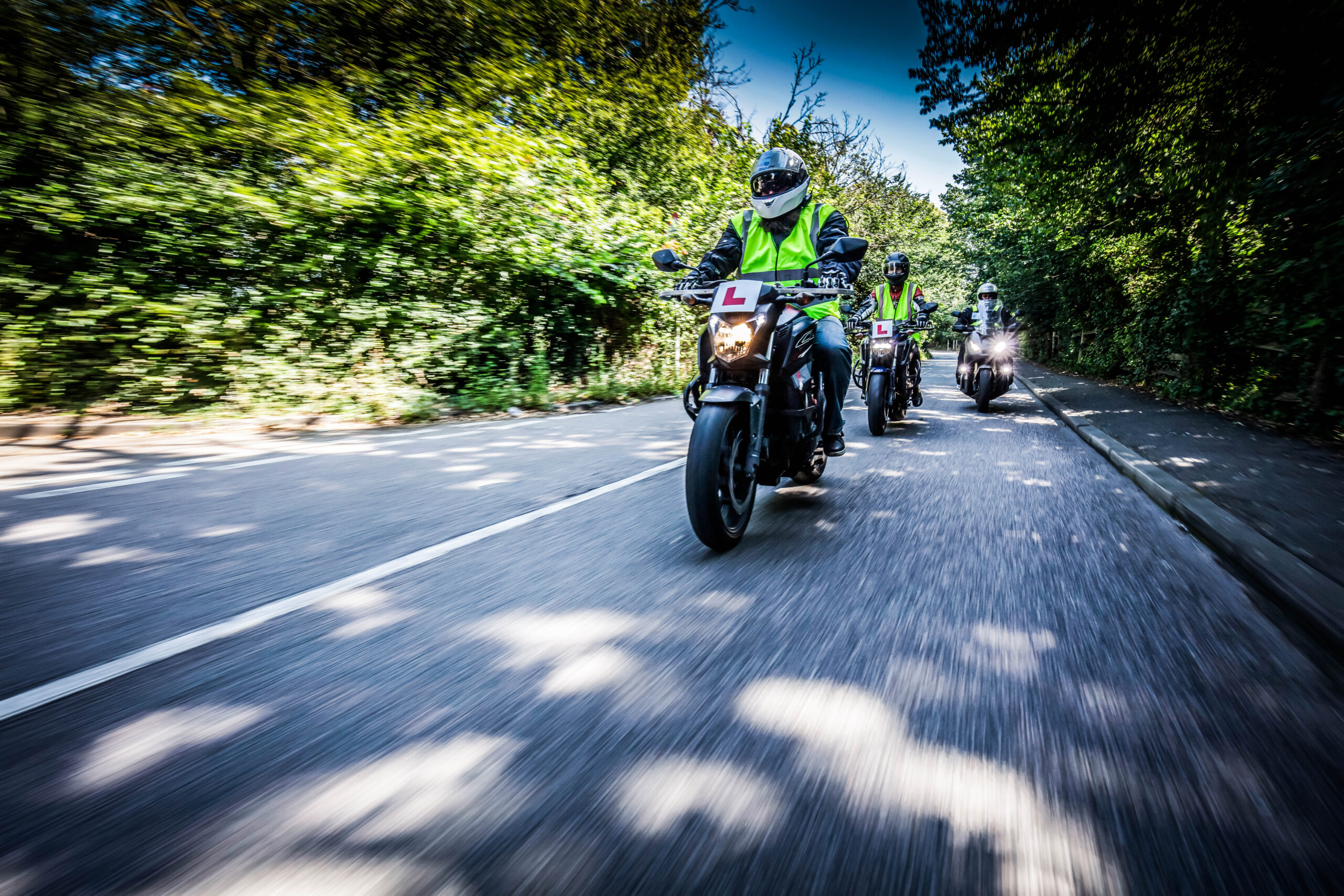Getting on two wheels promises adventure around every corner – whether you’re planning to commute daily on a motorcycle or have plans for weekend riding. To get started, motorcycle lessons are essential. Not only will you learn the practicalities of riding a motorcycle in traffic, the best UK motorcycle lessons will develop your confidence and competence right alongside your skill.
But not all motorcycle training is created equal. Choosing your motorcycle licence training on cost alone could have you forking out more than expected. That’s why it’s so important to balance value with price. It’ll ensure you reach the level of competence needed to pass your Mod 1 and Mod 2 licence tests without a hitch.
So, how do you find the best lessons for gaining a motorcycle licence? You make sure the motorcycle training school you choose ticks all the right boxes. That’ll ensure you get the training and support you need to develop your motorcycling skills quickly, smoothly and confidently. To make that as easy as possible, we’ve put together a simple checklist that’ll make your search for the ideal UK motorcycle lessons a cinch!
Your 7 point checklist for the best UK motorcycle lessons
The best motorcycle lessons set you up for success. That means looking for lessons that offer quality, safety, and a positive learning experience. Our checklist will help you narrow down your local motorcycle training options to pinpoint the best choice for you.
Reputation & Reviews
A training school’s reputation is a strong indicator of its quality. Start your research by cruising past online reviews and listening to what friends and family share about their own motorcycle training experiences.
- Check online reviews: Google Reviews and Trustpilot detail the experiences of past students. Pay attention to the number of stars, the review content, and the total number of reviews the school has collected. A 100% 5-star review rating from a school with three reviews is going to carry less weight than a 4.5-star rated school with thousands of past student’s testimonials. Look for recurring themes regarding the quality of instruction, customer service, and success rates.
- Word-of-Mouth: Your motorcyclist friends, family, or colleagues are a wealth of information when it comes to choosing motorcycle lessons, so tap into their knowledge. Ask them where they learned to ride and what their experience was like.
Accreditation & Standards
Check that any motorcycle school you’re considering meets industry requirements. You can verify the quality and legitimacy of their training by checking these standards:
- DVSA Approved Training Body (ATB): Only DVSA-accredited motorcycle instructors can issue your Compulsory Basic Training (CBT) certificate (DL196), which is essential for starting your journey of riding on public roads.
- MCIAC Gold Standard: Schools with the Motorcycle Industry Accreditation Centre (MCIAC) Gold Standard have proven they offer a higher level of service, quality and accreditation. This shows their commitment to exceptional training quality, excellent facilities, and high standards of instruction. A MCIAC rated school indicates they’re going above and beyond basic training requirements. At the end of the day, that means you’ve a better chance of an enhanced learning experience and success.
All-Inclusive Pricing & Transparency
Cheaper lessons can indicate hidden costs. This path often leads to unexpected expenses and less value for your money. So you don’t fall into that trap, ask about:
- Bike Hire: Is the motorcycle provided for your training and tests?
- Insurance: Does the course fee cover insurance for the training motorcycles?
- Fuel: Is the cost of fuel included in the overall price?
- Gear Provision: Will the school provide essential safety gear (helmet, jacket, gloves, etc.)?
- Test Fees: Are the DVSA Mod 1 and Mod 2 practical test fees included, or will you need to book and pay for these separately?
- Re-test Policies: What happens if you don’t pass a test on the first try? Are there discounted retest fees or specific policies in place?
Choosing a school with all-inclusive pricing gives you peace of mind. It means you’ll avoid unpleasant surprises. It delivers better value than a cheaper course with numerous add-ons.
Instructor Quality & Approach
The quality of your instructor significantly impacts your learning experience and confidence. Look for:
- Experienced and Patient: Instructors should be highly experienced riders with a calm and patient teaching style.
- DVSA-Qualified: As mentioned, all instructors for CBT must be DVSA-accredited. For full licence training, while not strictly required for private lessons, a DVSA-qualified instructor is highly recommended for structured, effective learning and easy progression to passing your licence tests.
- Tailored Instruction: The best instructors adapt their teaching methods to your individual learning style and progress, providing personalised feedback and support. Our instructors learn how to do this by gaining their Level 3 Award in Education and Training before becoming qualified instructors.
- Instructor-to-Student Ratio: A lower ratio generally means more personalised attention, that accelerates your learning.
- Confidence Building: Effective instruction goes beyond just teaching skills; it builds your confidence and competence on the road. These qualities make you a safer rider.
Facilities
The learning environment plays a role in your comfort and ability to focus:
- Dedicated Off-Road Training Area: For Mod 1 training, a large, private, tarmacked area, inaccessible to the public, is essential. This allows you to practice manoeuvres safely without the pressures of public roads.
- Modern, Well-Maintained Bikes: The training motorcycles should be modern, well-maintained, and within the same power to weight ratios as the type of licence you are pursuing.
Test Integration & Flexibility
A good training school will streamline the process of getting your licence:
- Optimal Test Scheduling: They should arrange your training sessions and test dates (Mod 1 and Mod 2) strategically to maximise your chances of passing on the first attempt. This means booking tests as close to the end of your full training days as possible.
- Flexibility in Scheduling: While structured courses are beneficial, inquire about their flexibility with scheduling to accommodate your availability too.
Customer Service
Your initial interactions with the training school can give you a good sense of their approach:
- Initial Call & Clear Communication: Are they helpful and informative when you first enquire? Do they provide clear and concise answers to your questions? Are they knowledgeable about motorcycle licences and the different paths available to you for gaining one?
- Supportive Atmosphere: You want to feel comfortable and supported throughout your learning journey. A friendly and encouraging environment makes a huge difference.
Once you’ve gone through your checklist and narrowed down your choices to the ideal motorcycle training school for you, what’s next? You book your course, of course! Read on to find out what you can expect from motorbike lessons.
Getting started: UK motorcycle training basics
Ready to get on two wheels? Understanding the basic structure of UK motorcycle training will build your confidence and help the days roll a little more smoothly. While the specific licence you’ll pursue depends on your age and aspirations, all new riders typically begin with Compulsory Basic Training (CBT).

Understanding the licence training stages
Compulsory Basic Training is the initial training you need to gain the fundamental skills and knowledge to ride safely on public roads (excluding motorways) as a learner. Your CBT certificate is valid for two years.
- Want to know more about what CBT involves and who needs it? Read our tips for preparing for your CBT, find out how long the CBT course is, and whether or not you’ll need further motorcycle licence training after getting your CBT certificate.
Full licence training prepares you for the A1, A2 or full unrestricted A motorcycle licence tests.

- Confused about which full licence is right for you? Discover which licence level suits your motorcycle dreams best, the ideal path to the motorcycle licence you want, and how to reach your ideal motorcycle licence level faster.
Overcoming your fears and gaining confidence on two wheels
It’s completely normal to feel a mix of excitement and apprehension when you’re thinking about learning to ride a motorbike. The idea of navigating traffic on two wheels can seem daunting, and many new riders share concerns about safety, balance, or simply the unknown.
But here’s the reassuring truth: motorcycle training is specifically designed to transform those anxieties into confidence.
Professional instructors understand your fears. They’ll guide you through each step at a pace that’s right for you, starting with the basics in a safe, controlled environment. You’ll gradually build your skills, from mastering the clutch to navigating junctions, ensuring that each new challenge feels achievable. To help things along, try covering these three steps before you take your CBT course:
- Learn to ride a bicycle The balance you learn riding a bicycle is easily transferred to a motorcycle, moped or scooter. Give yourself a head start on motorcycle lessons by developing your muscle memory on a bike. That’ll give you more time and headspace to focus on gaining other essential skills.
- Revise your road rules Take a read through the Highway Code so you’re up to scratch on the UK road rules. It’ll make element D of your CBT course run a lot more smoothly.
- Look where you want to go Don’t fall into the trap of target fixation. Instead, stay focussed on your goal – the clear path ahead. It’ll make mastering control of your motorcycle faster and easier.
Finally, don’t let age be a barrier! Whether you’re 16 or 60+, people of all ages successfully learn to ride motorbikes. The focus is always on your individual progress and comfort.
With the right motorbike lessons, you’ll not only gain the practical skills but also the mental fortitude to ride safely and enjoyably.
Embrace your journey, trust the training process, and you’ll soon discover the incredible freedom and exhilaration that comes with riding on two wheels. Ready to roll? Book your motorcycle lessons with us today!


